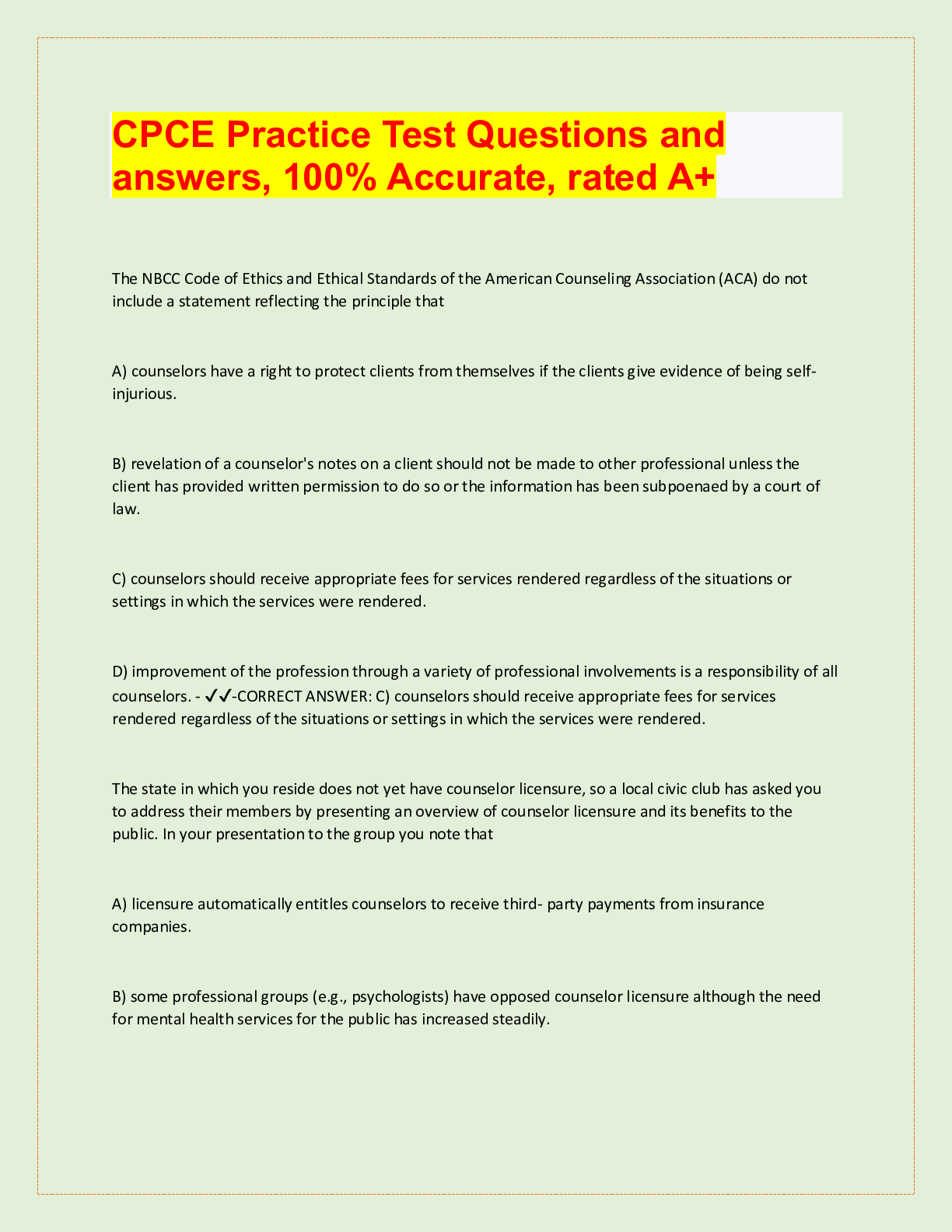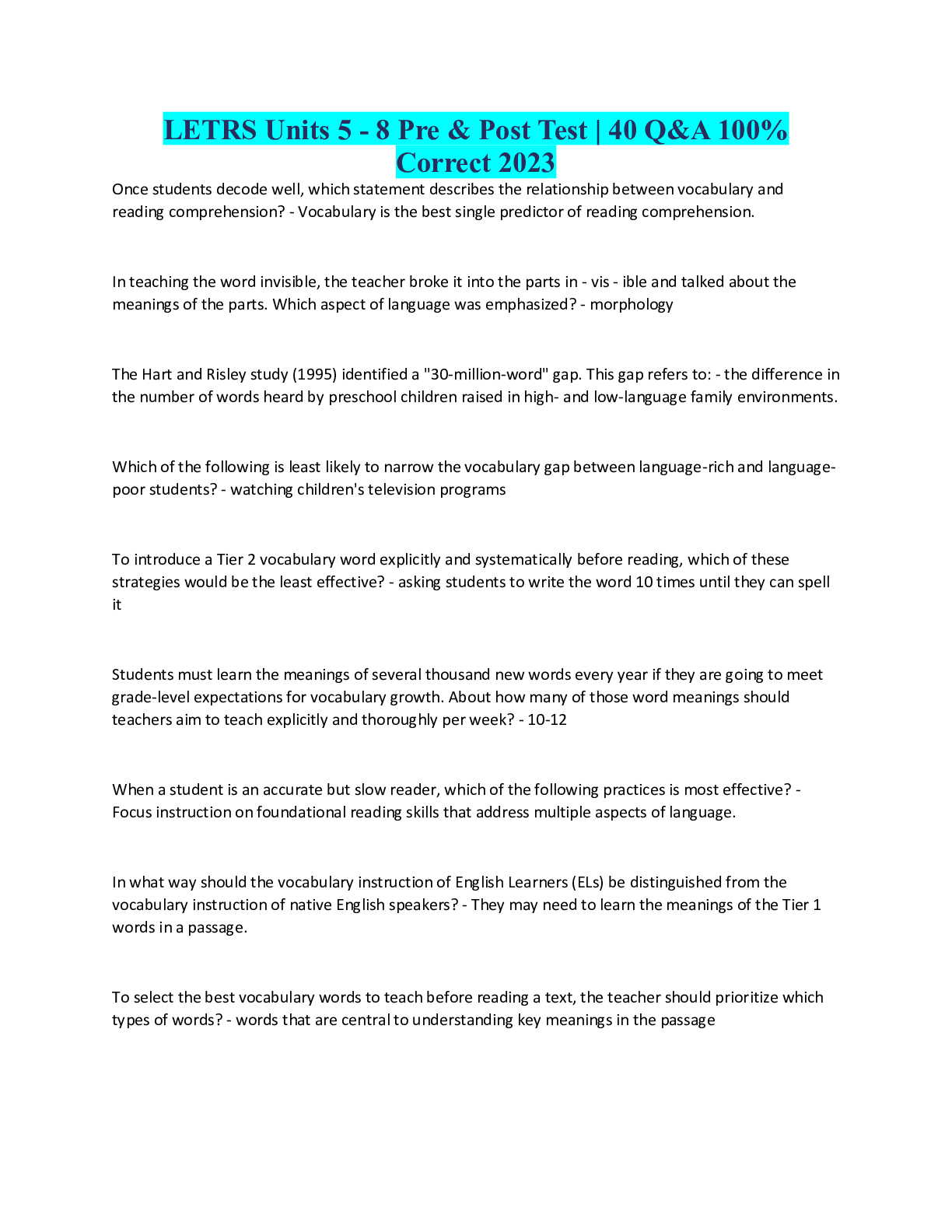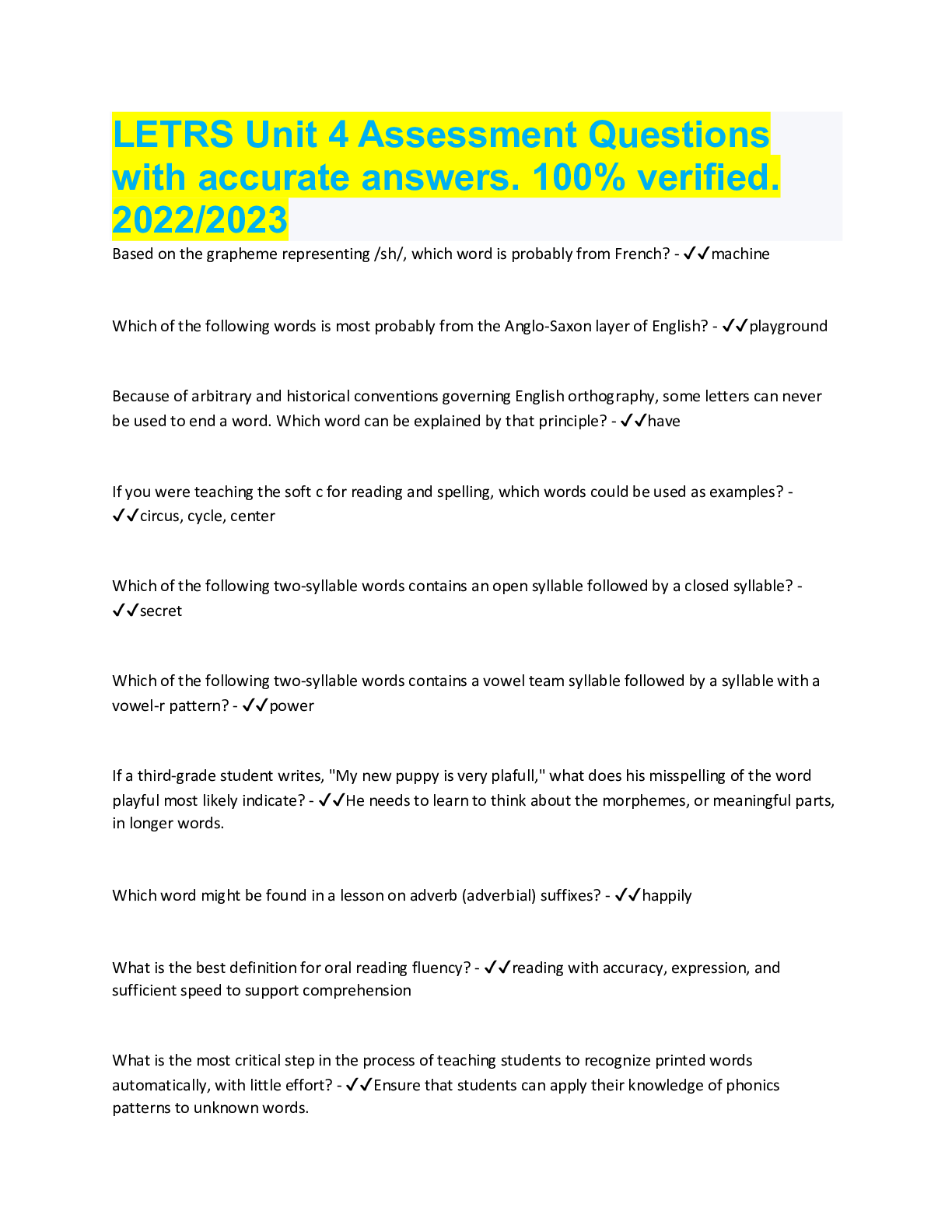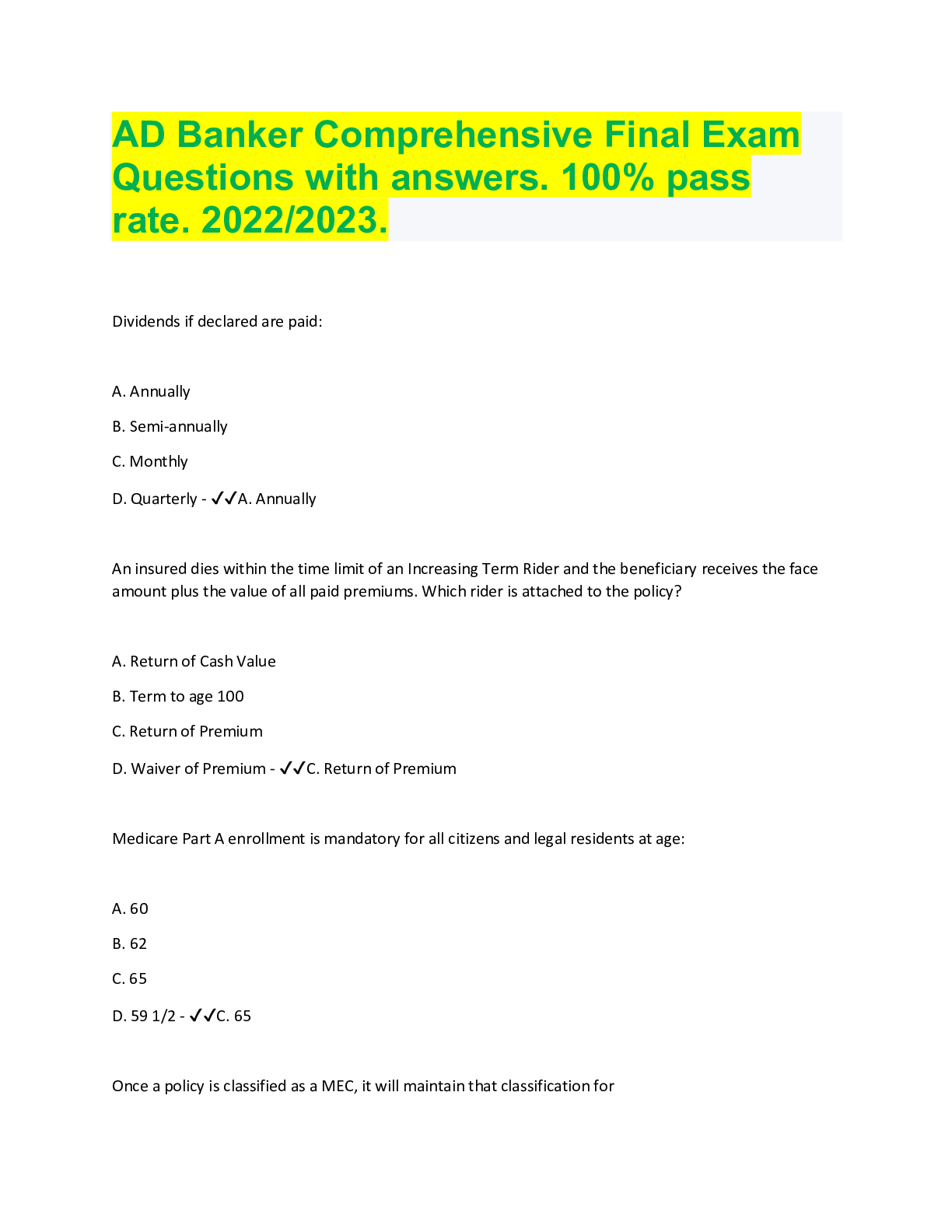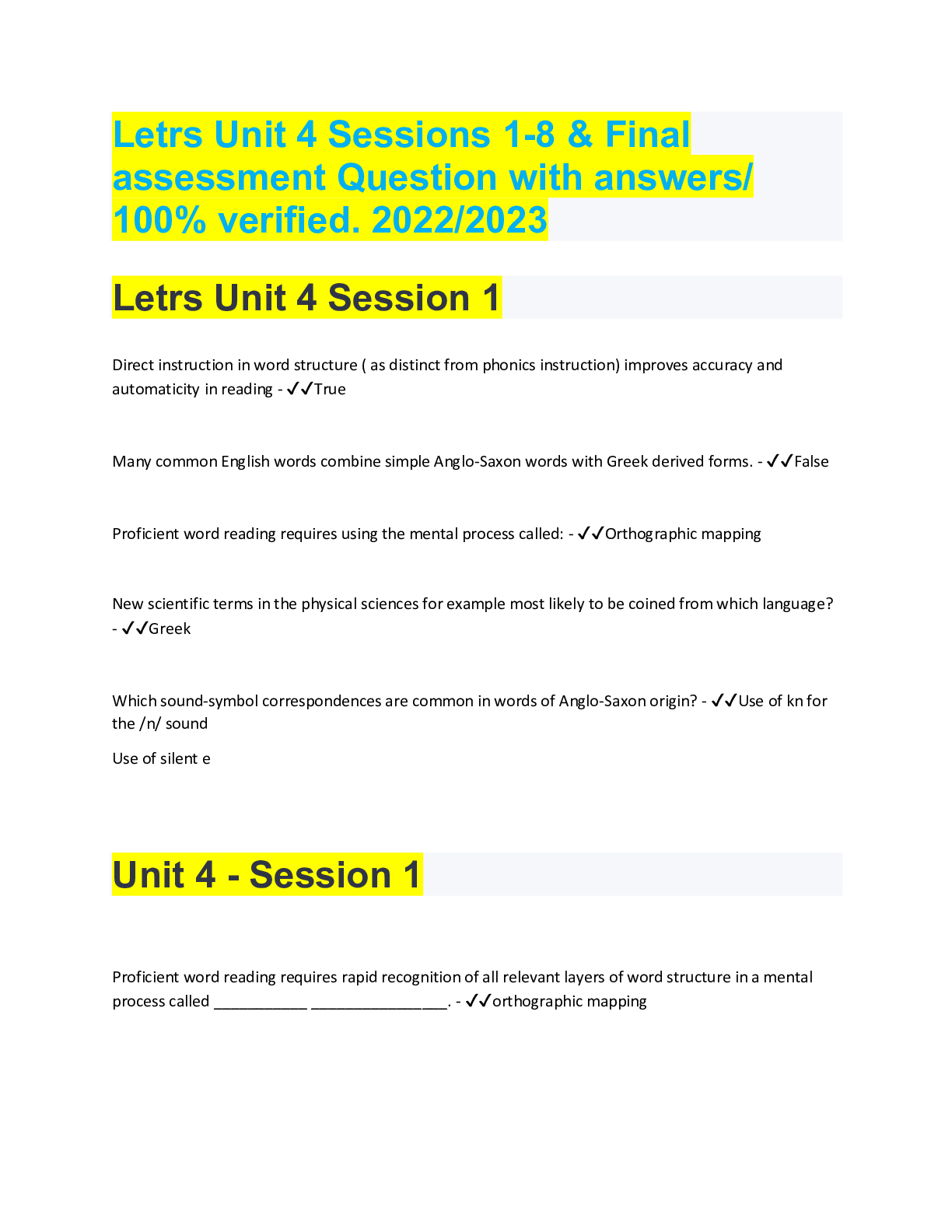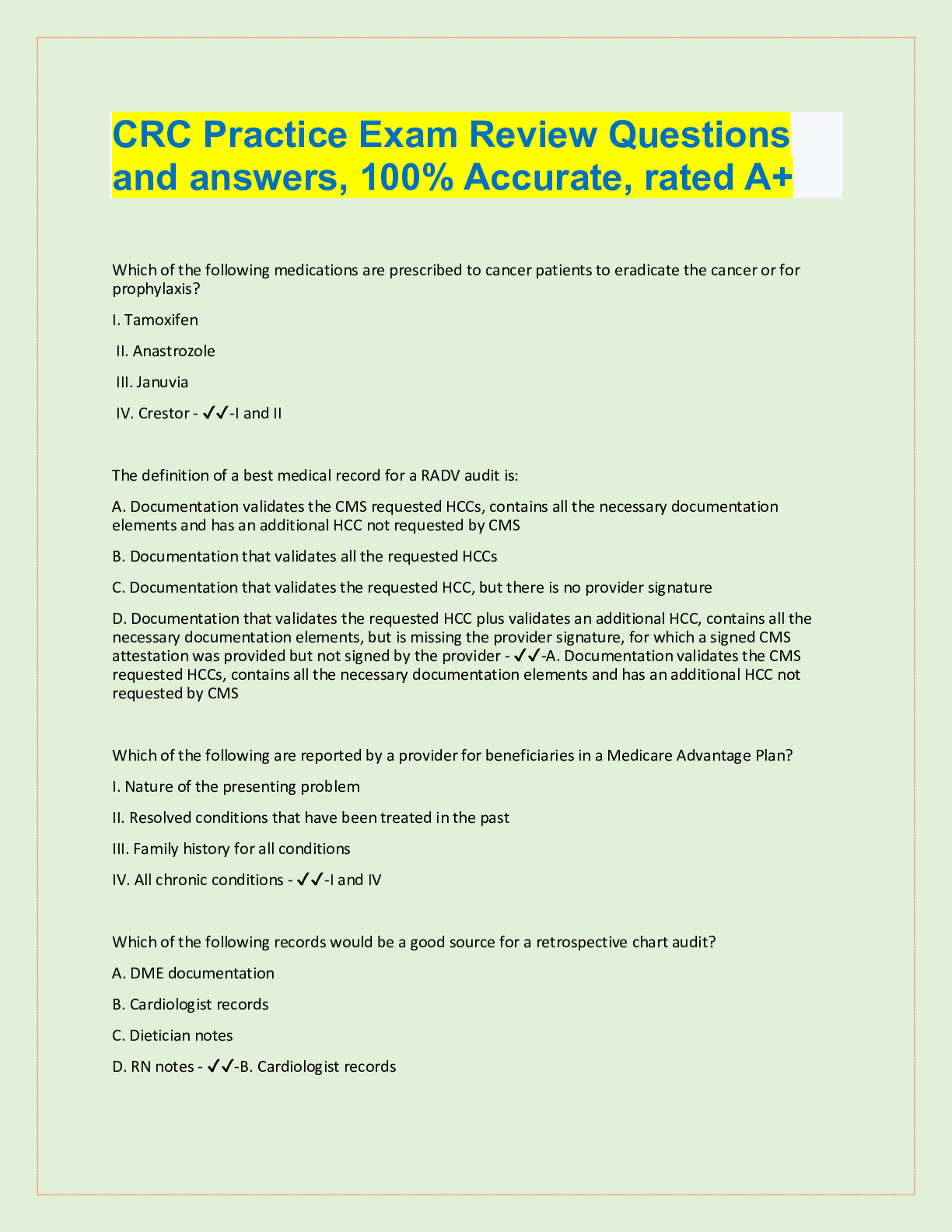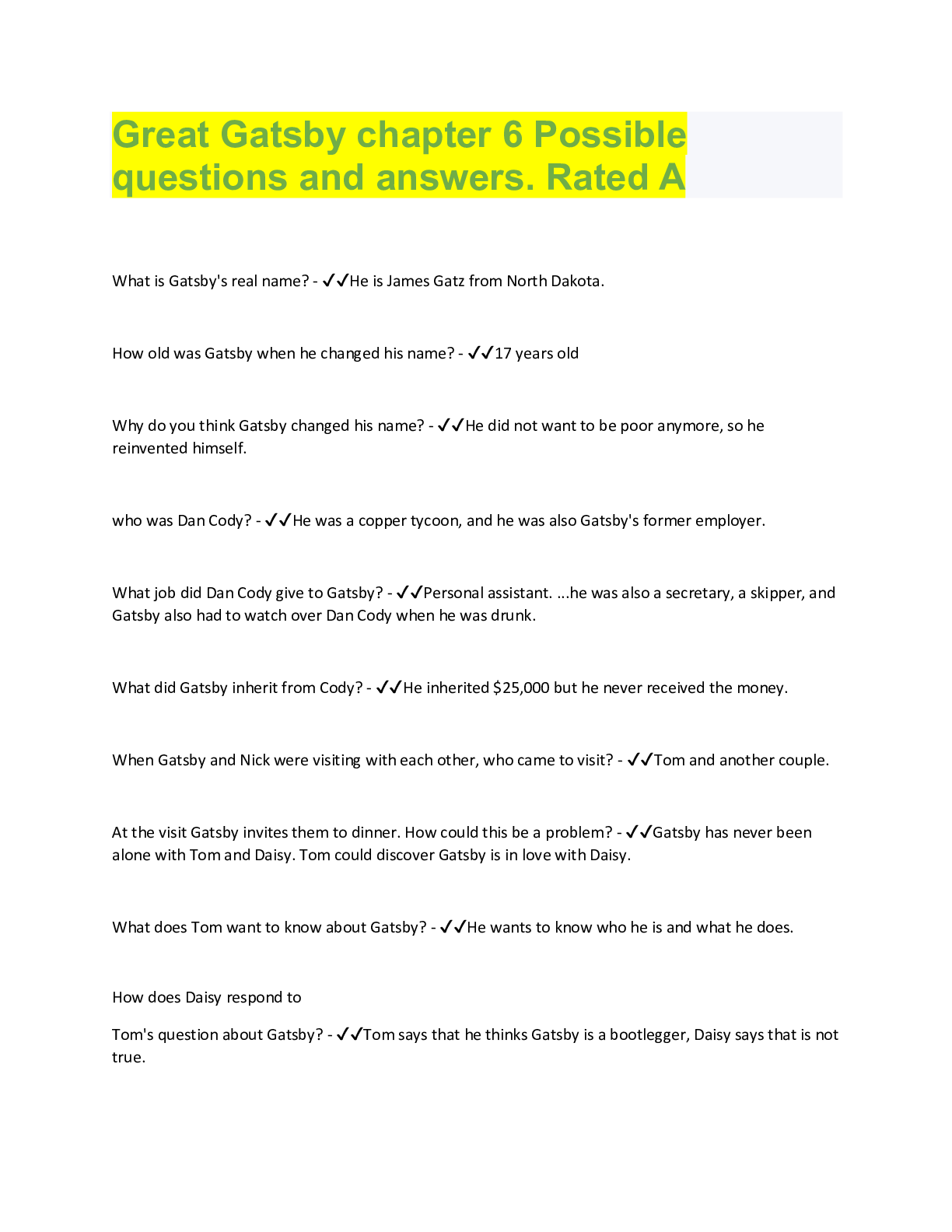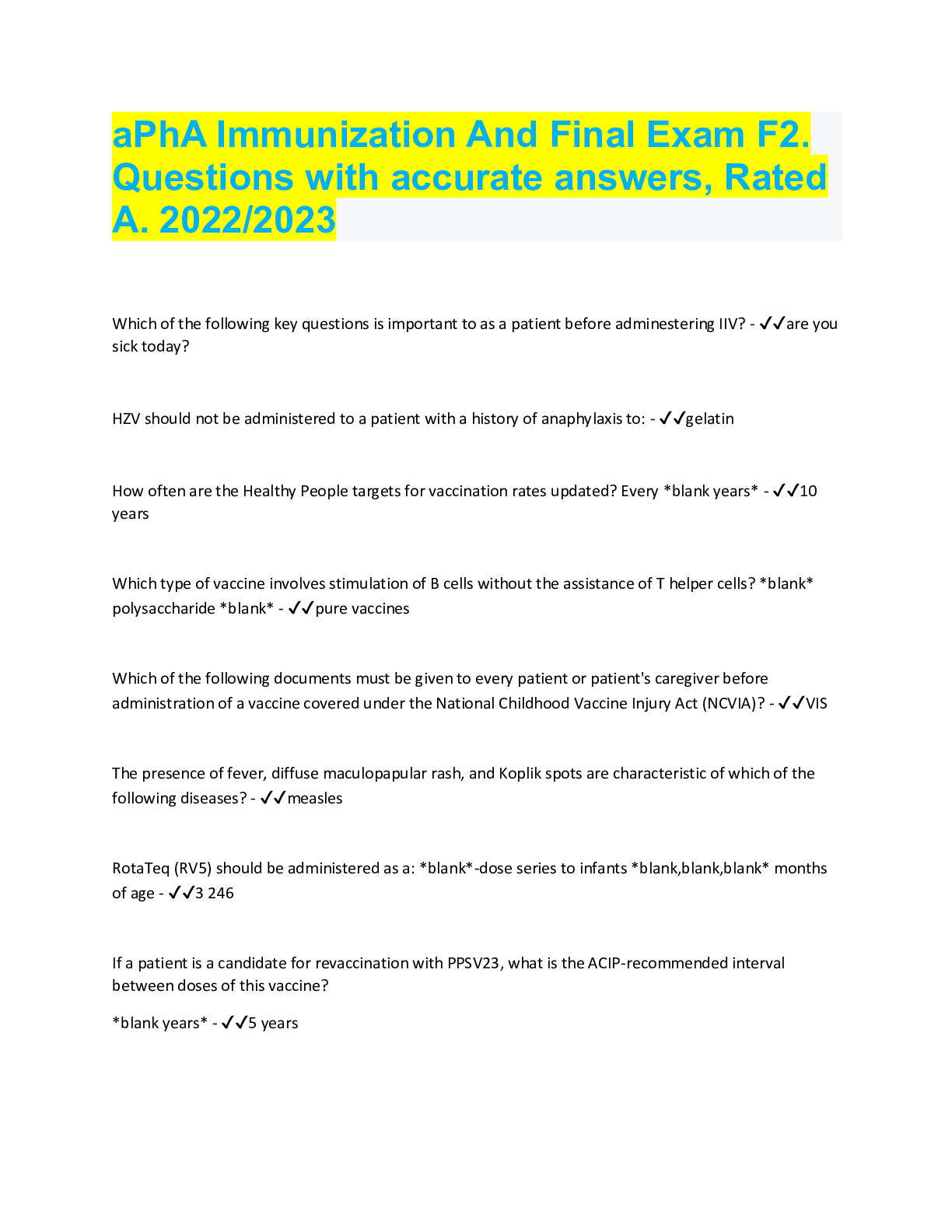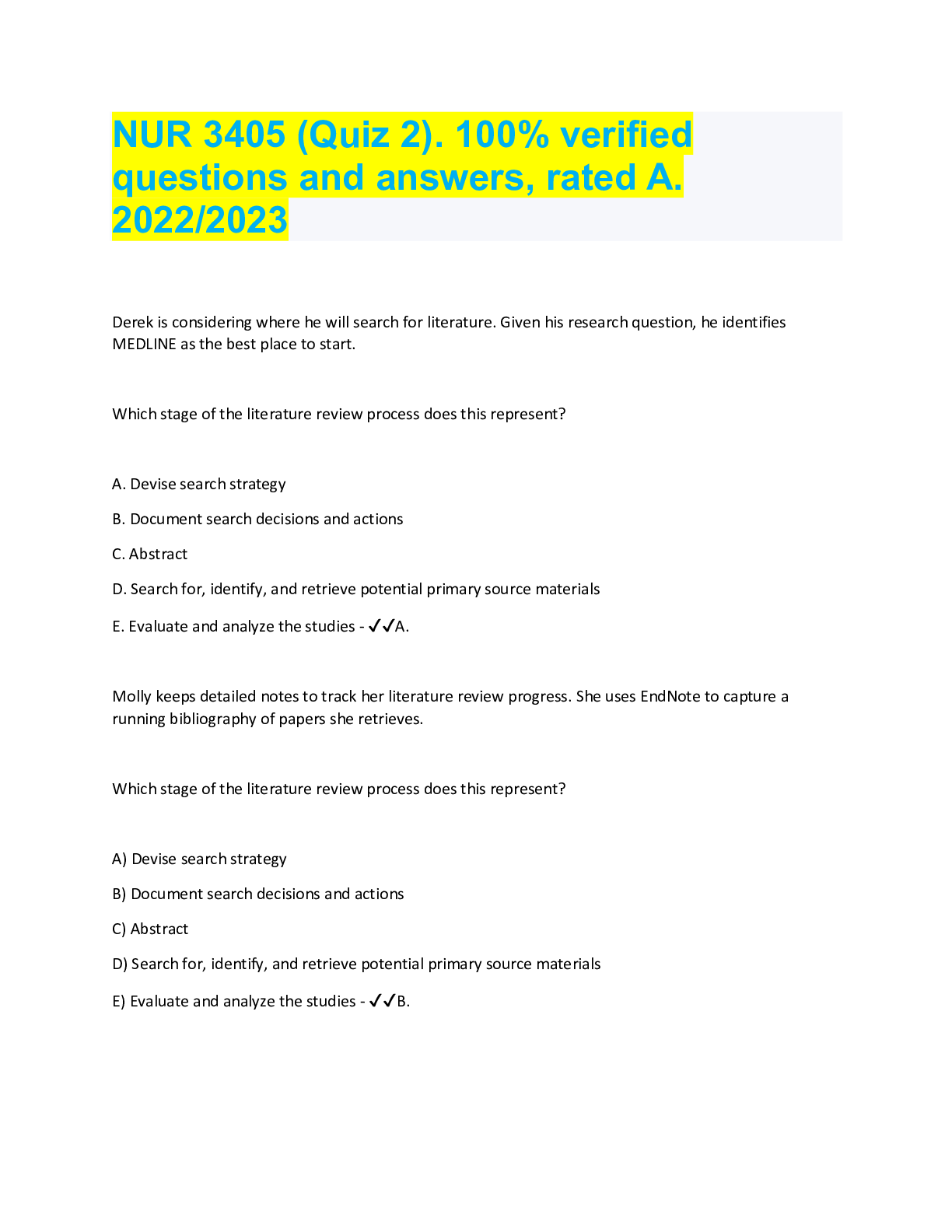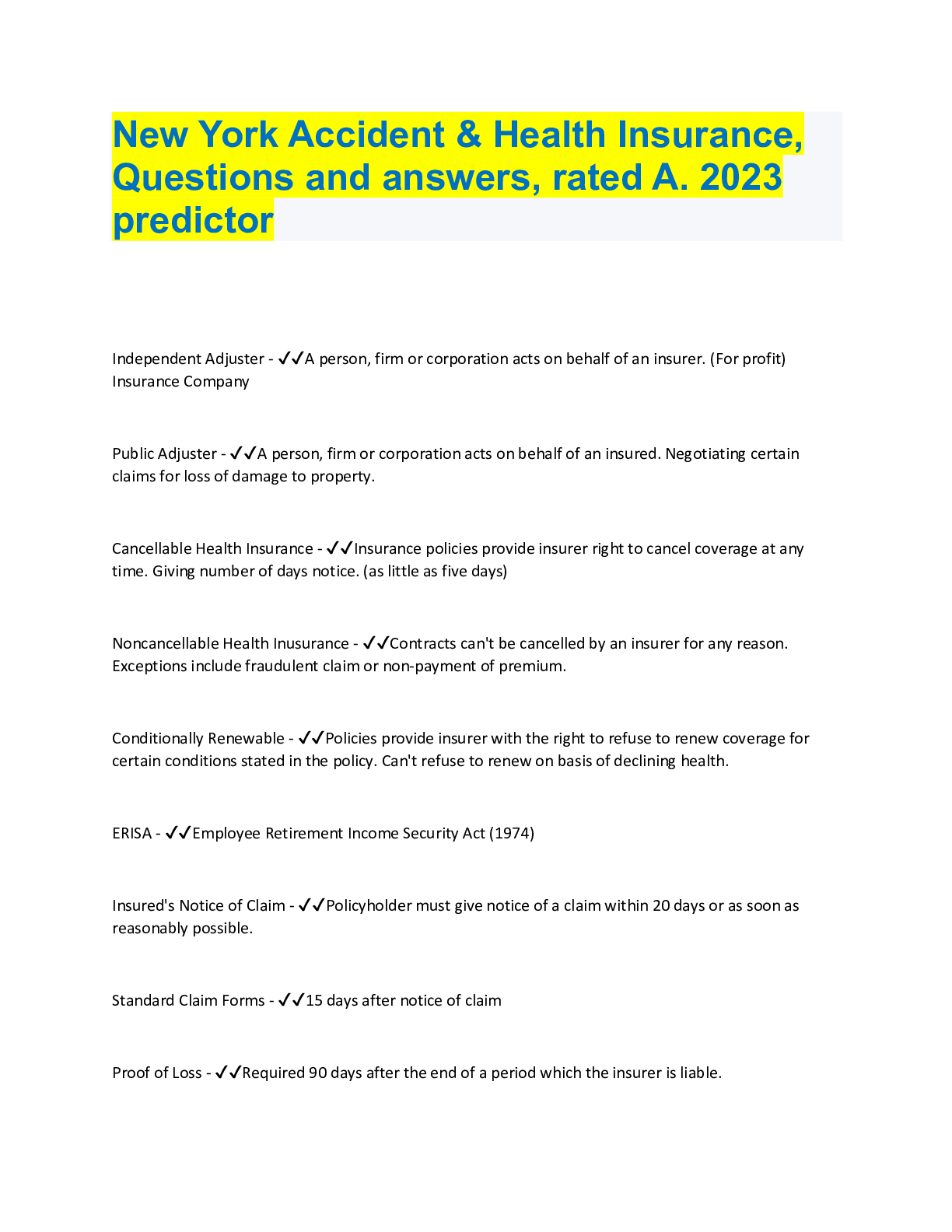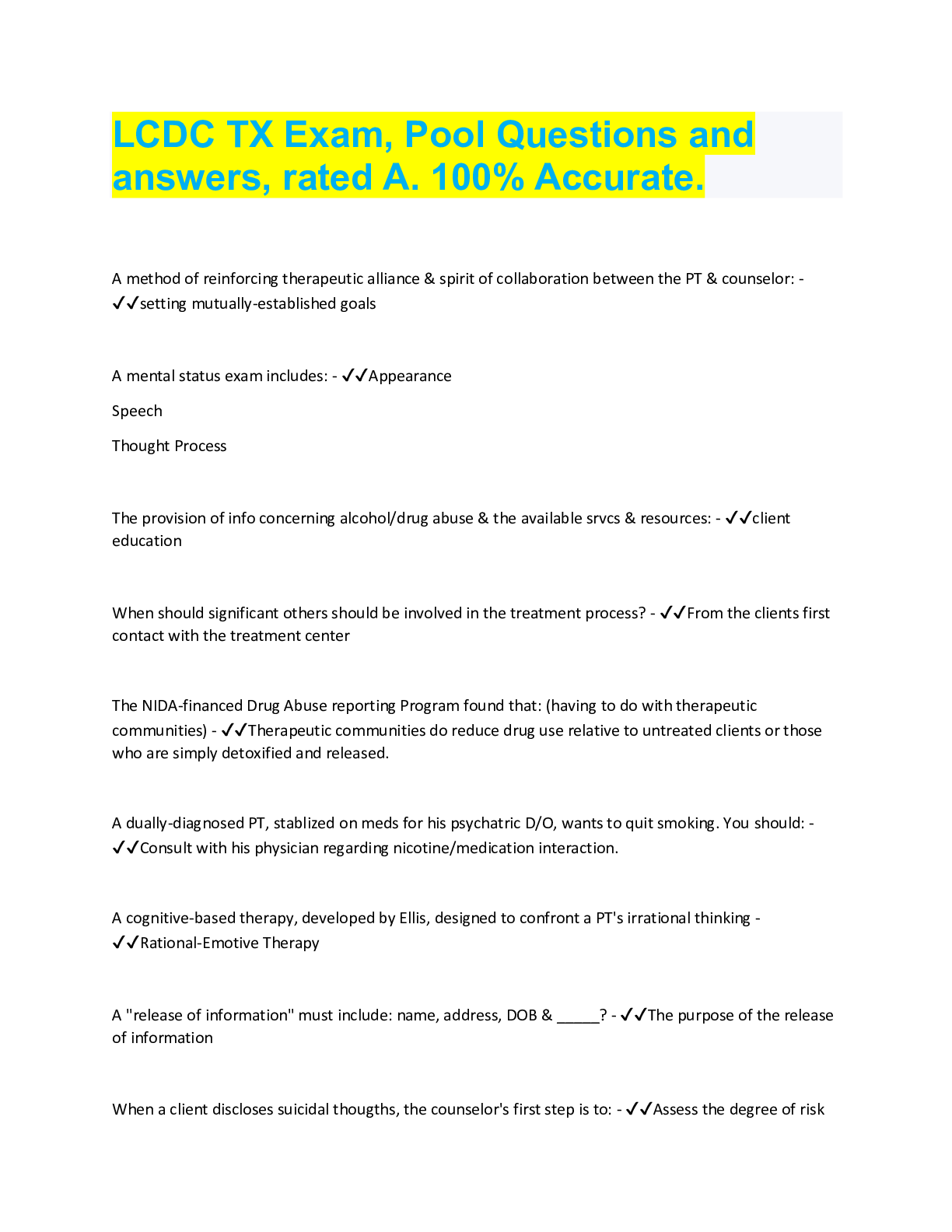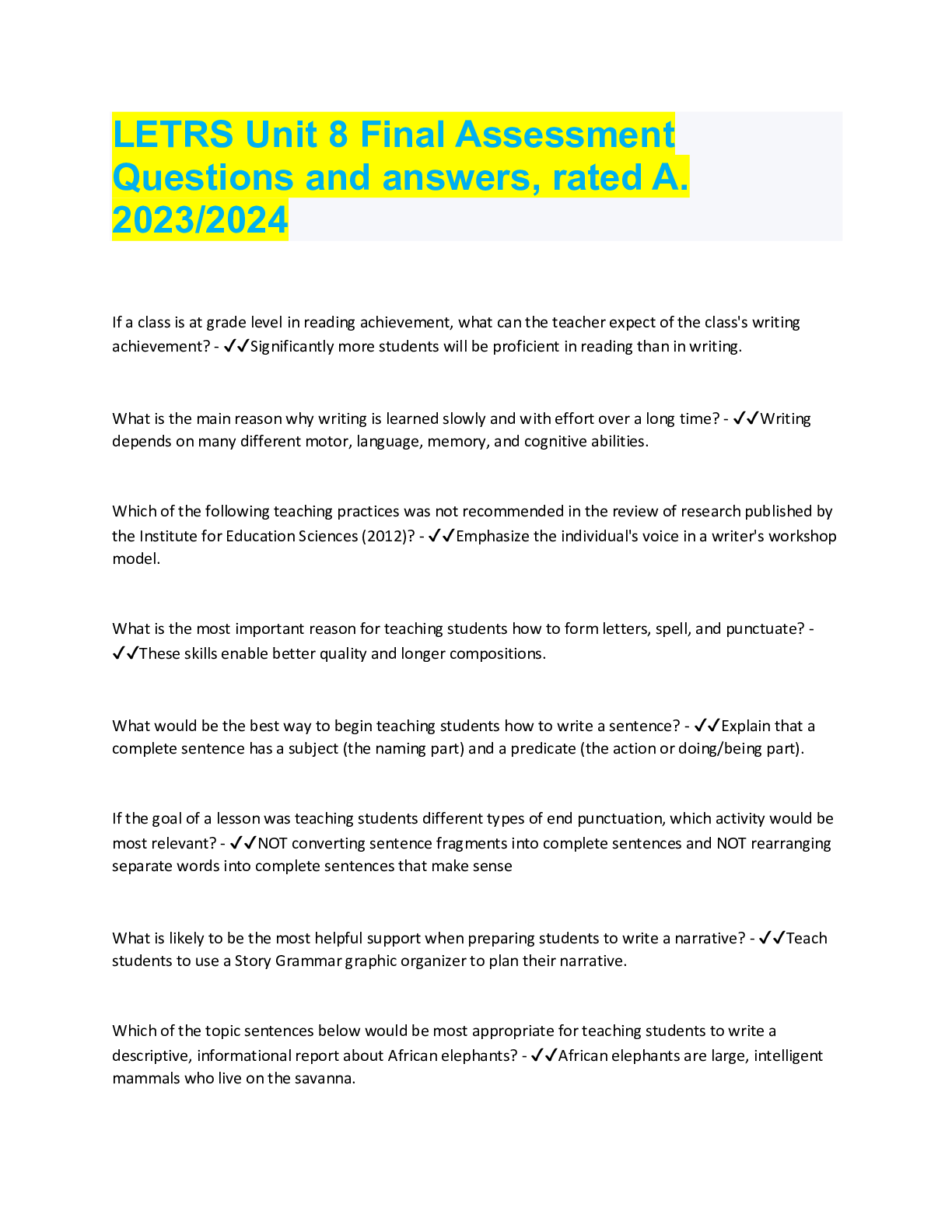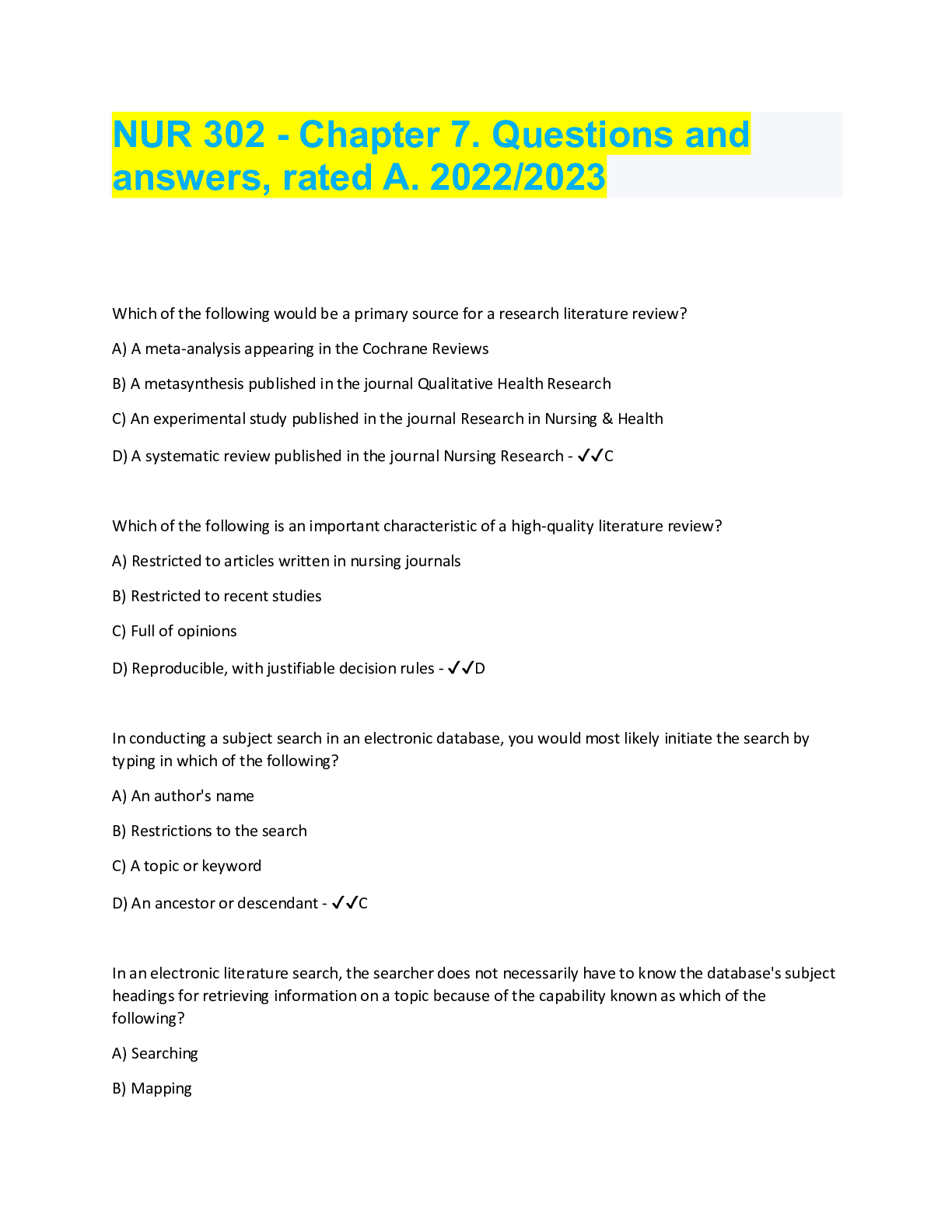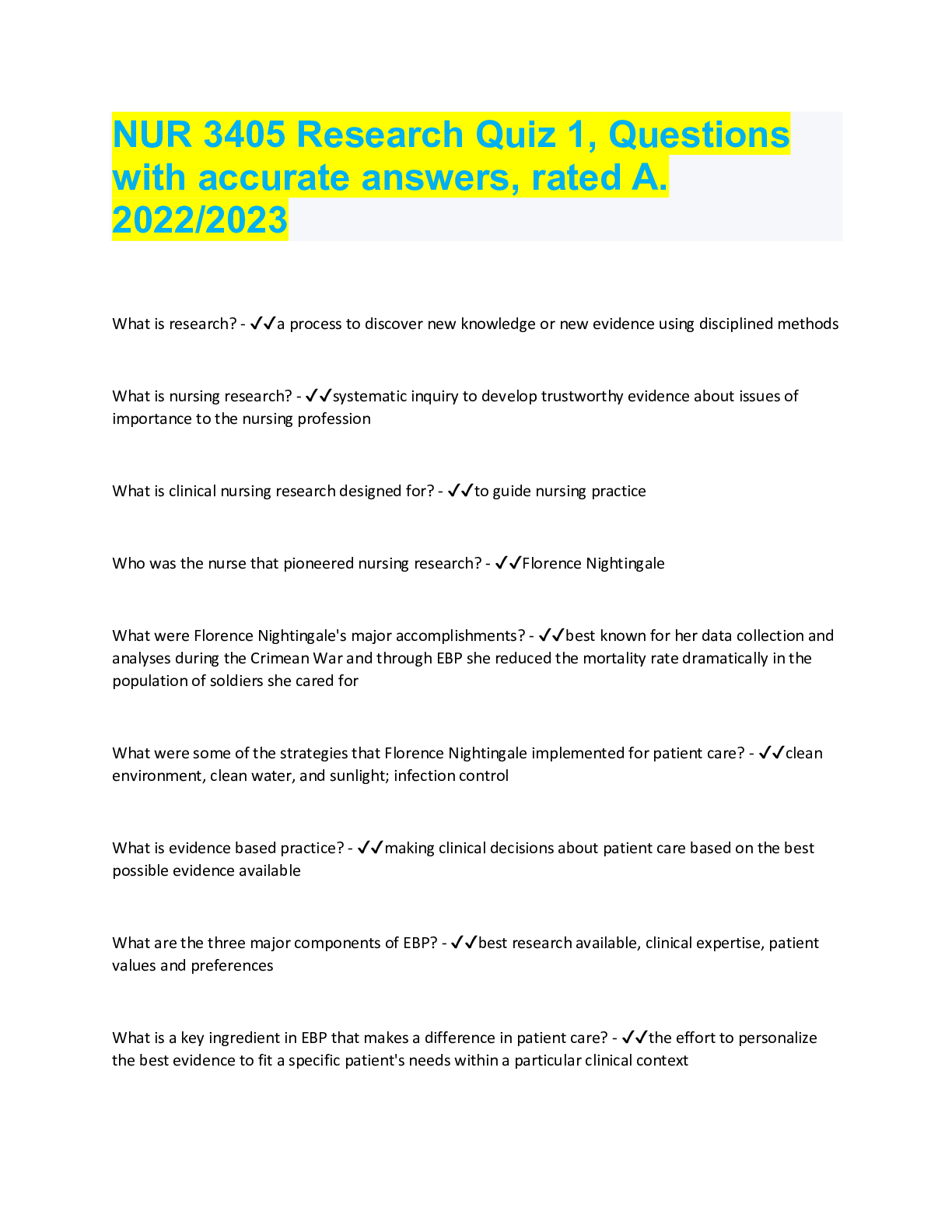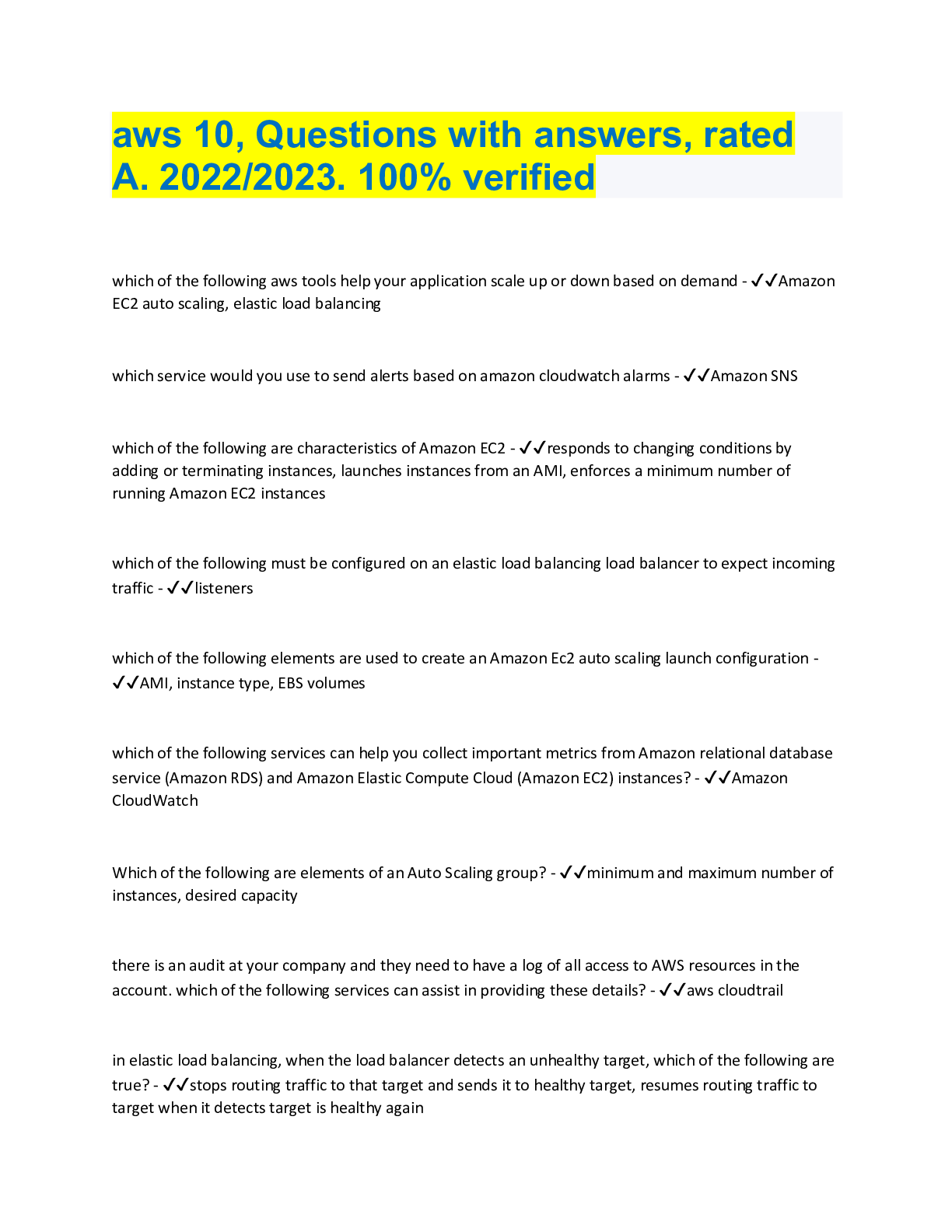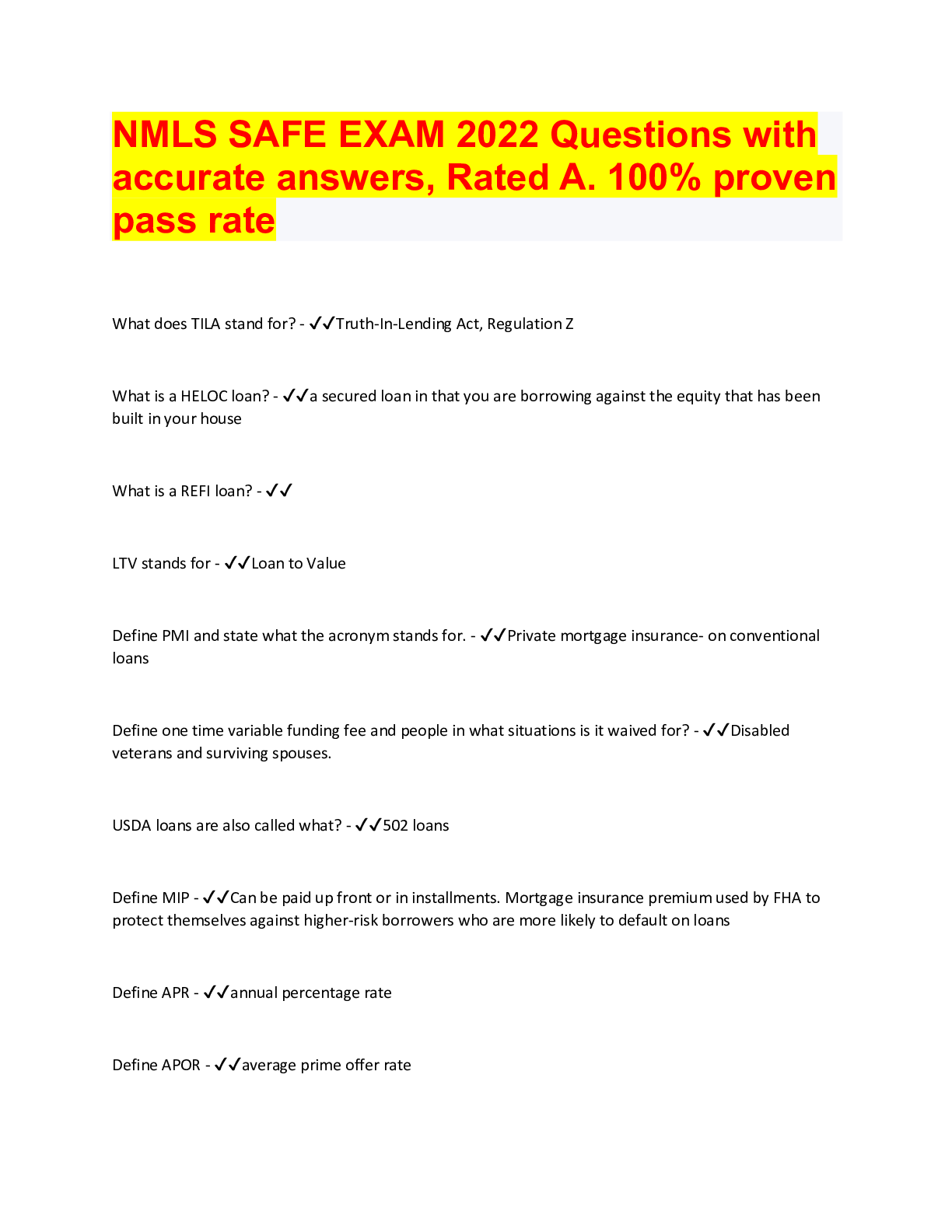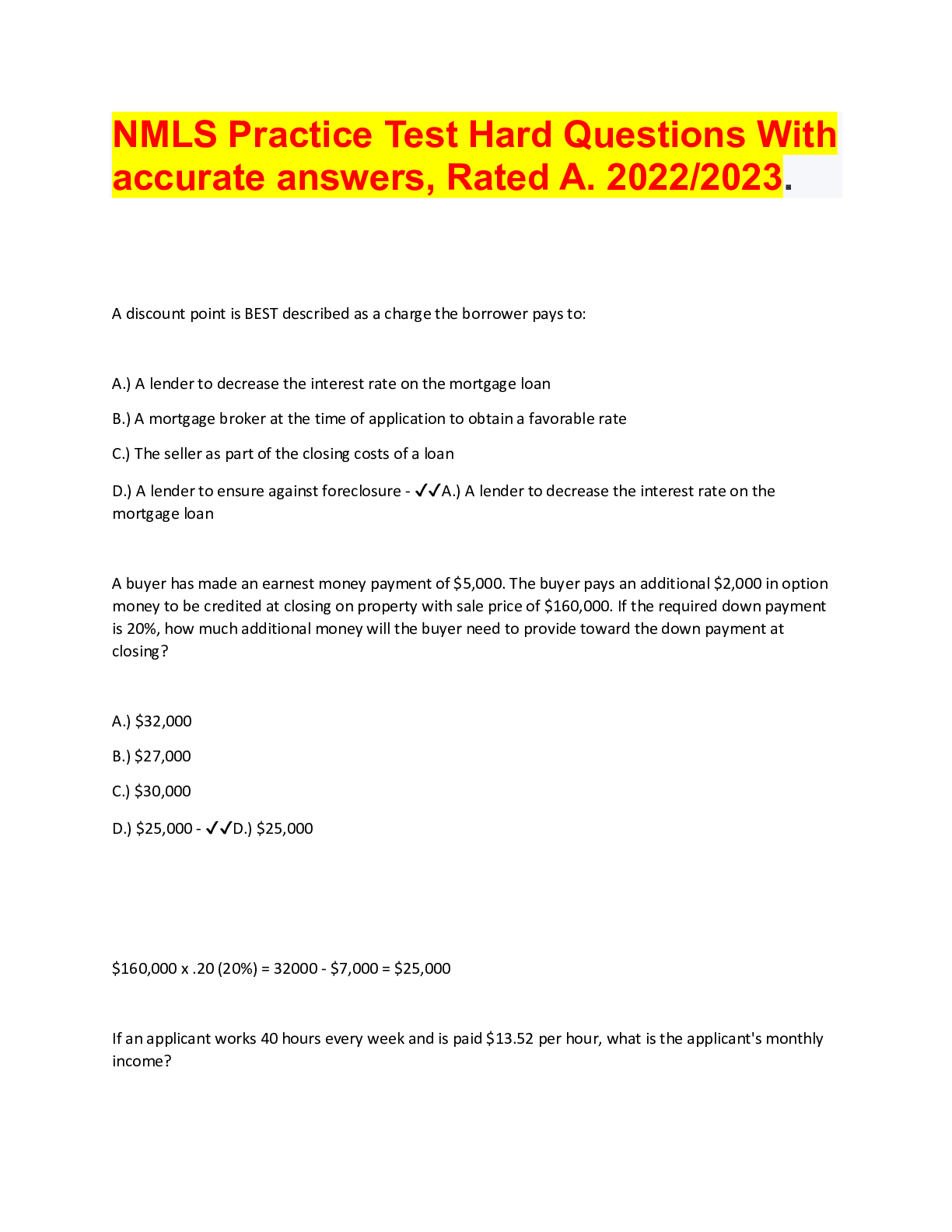*NURSING > QUESTIONS & ANSWERS > NR 302 Chamberlain HESI Study, Questions withn accurate answers, rated A. 2022 (All)
NR 302 Chamberlain HESI Study, Questions withn accurate answers, rated A. 2022
Document Content and Description Below
NR 302 Chamberlain HESI Study, Questions withn accurate answers, rated A. 2022 In the majority culture of America, coughing, sweating, and diarrhea are symptoms of an illness. For some individual... s of Mexican-American origin, however, these symptoms are a normal part of living. The nurse recognizes that this is true, probably because Mexican-Americans: A) have less efficient immune systems and are often ill. B) consider these symptoms a part of normal living, not symptoms of ill health. C) come from Mexico and coughing is normal and healthy there. D) are usually in a lower socioeconomic group and are more likely to be sick. - ✔✔B) consider these symptoms a part of normal living, not symptoms of ill health. Page: 27 The nurse needs to identify the meaning of health to the patient, remembering that concepts are derived, in part, from the way in which members of the cultural group define health The nurse recognizes that working with children with a different cultural perspective may be especially difficult because: A) children have spiritual needs that are influenced by their stages of development. B) children have spiritual needs that are direct reflections of what is occurring in their homes. C) religious beliefs rarely affect the parents' perceptions of the illness. D) parents are often the decision makers, and they have no knowledge of their children's spiritual needs. - ✔✔A Page: 20. Illness during childhood may be an especially difficult clinical situation. Children, as well as adults, have spiritual needs that vary according to the child's developmental level and the religious climate that exists in the family. The other statements are not correct. The nurse is preparing to do a functional assessment. Which statement best describes the purpose of a functional assessment? A. It assesses how the individual is coping with life at home. B. It determines how children are meeting developmental milestones. C. It can identify any problems with memory the individual may be experiencing. D. It helps to determine how a person is managing day-to-day activities. - ✔✔D Page: 56. The functional assessment measures how a person manages day-to-day activities. The other answers do not reflect the purpose of a functional assessment. During an examination, the nurse can assess mental status by which activity? A) Examining the patient's electroencephalogram B) Observing the patient as he or she performs an IQ test C) Observing the patient and inferring health or dysfunction D) Examining the patient's response to a specific set of questions - ✔✔C Pg. 67: Mental status cannot be scrutinized directly like the characteristics of skin or heart sounds. Its functioning is inferred through assessment of an individual's behaviors, such as consciousness, language, mood and affect, and other aspects. The nurse would use bimanual palpation technique in which situation? A) Palpating the thorax of an infant B) Palpating the kidneys and uterus C) Assessing pulsations and vibrations D) Assessing the presence of tenderness and pain - ✔✔B Pg 115: Bimanual palpation requires the use of both hands to envelop or capture certain body parts or organs such as the kidneys, uterus, or adnexa. The other situations are not appropriate for bimanual palpation. The nurse is examining an infant and prepares to elicit the Moro reflex at which time during the examination? A) When the infant is sleeping B) At the end of the examination C) Before auscultation of the thorax D) Halfway through the examination - ✔✔B Pg 122: Elicit the Moro or "startle" reflex at the end of the examination because it may cause the infant to cry. During a nutritional assessment, why is it important for the nurse to ask a patient what medications he or she is taking? A) Certain drugs can affect the metabolism of nutrients. B) The nurse needs to assess the patient for allergic reactions. C) Medications need to be documented on the record for the physician's review. D) Medications can affect one's memory and ability to identify food eaten in the last 24 hours. - ✔✔A) Certain drugs can affect the metabolism of nutrients. Page: 183 Analgesics, antacids, anticonvulsants, antibiotics, diuretics, laxatives, antineoplastic drugs, steroids, and oral contraceptives are drugs that can interact with nutrients, impairing their digestion, absorption, metabolism, or use. The other responses are not correct. A 65-year-old man with emphysema and bronchitis has come to the clinic for a follow-up appointment. On assessment, the nurse might expect to see which assessment finding? A) Anasarca B) Scleroderma C) Pedal erythema D) Clubbing of the nails - ✔✔D Pages: 213. Clubbing of the nails occurs with congenital cyanotic heart disease, neoplastic, and pulmonary diseases. The other responses are assessment findings not associated with pulmonary diseases. A patient has been admitted for severe psoriasis. The nurse can expect to see what finding in the patient's fingernails? A) Splinter hemorrhages B) Paronychia C) Pitting D) Beau lines - ✔✔C Pages: 236. Pitting nails are characterized by sharply defined pitting and crumbling of the nails with distal detachment, and they are associated with psoriasis. See Table 12-13 for descriptions of the other terms. During an examination, the nurse knows that Paget's disease would be indicated by which of these assessment findings? A) Positive Macewen sign B) Premature closure of the sagittal suture C) Headache, vertigo, tinnitus, and deafness D) Elongated head with heavy eyebrow ridge - ✔✔C Paget's disease occurs more often in males and is characterized by bowed long bones, sudden fractures, and enlarging skull bones that press on cranial nerves causing symptoms of headache, vertigo, tinnitus, and progressive deafness. (This info is not in our texts for HA) A woman comes to the clinic and states, "I've been sick for so long! My eyes have gotten so puffy, and my eyebrows and hair have become coarse and dry." The nurse will assess for other signs and symptoms of: A) cachexia. B) Parkinson's syndrome. C) myxedema. D) scleroderma. - ✔✔C Pages: 277. Myxedema (hypothyroidism) is a deficiency of thyroid hormone that, when severe, causes a non pitting edema or myxedema. The patient will have a puffy edematous face especially around eyes (periorbital edema), coarse facial features, dry skin, and dry, coarse hair and eyebrows. See Table 13-4, Abnormal Facial Appearances with Chronic Illnesses, for descriptions of the other responses. The physician reports that a patient with a neck tumor has a tracheal shift. The nurse is aware that this means that the patient's trachea is: A) pulled to the affected side. B) pushed to the unaffected side. C) pulled downward. D) pulled downward in a rhythmic pattern - ✔✔B Pages: 262 The trachea is pushed to the unaffected side with an aortic aneurysm, a tumor, unilateral thyroid lobe enlargement, and pneumothorax. The trachea is pulled to the affected side with large atelectasis, pleural adhesions, or fibrosis. Tracheal tug is a rhythmic downward pull that is synchronous with systole and occurs with aortic arch aneurysm. A mother asks when her newborn infant's eyesight will be developed. The nurse should reply: A) "Vision is not totally developed until 2 years of age." B) "Infants develop the ability to focus on an object at around 8 months." C) "By about 3 months, infants develop more coordinated eye movements and can fixate on an object." D) "Most infants have uncoordinated eye movements for the first year of life." - ✔✔C) Page: 285. Eye movements may be poorly coordinated at birth, but by 3 to 4 months of age, the infant should establish binocularity and should be able to fixate on a single image with both eyes simultaneously. The nurse notices the presence of periorbital edema when performing an eye assessment on a 70-year-old patient. The nurse should: A) check for the presence of exophthalmos. B) suspect that the patient has hyperthyroidism. C) ask the patient if he or she has a history of heart failure. D) assess for blepharitis because this is often associated with periorbital edema. - ✔✔C Page: 313. Periorbital edema occurs with local infections, crying, and systemic conditions such as heart failure, renal failure, allergy, and hypothyroidism. Periorbital edema is not associated with blepharitis. A patient comes to the emergency department after a boxing match, and his left eye is swollen almost shut. He has bruises on his face and neck. He says he is worried because he "can't see well" from his left eye. The physician suspects retinal damage. The nurse recognizes that signs of retinal detachment include: A) loss of central vision. B) shadow or diminished vision in one quadrant or one half of the visual field. C) loss of peripheral vision. D) sudden loss of pupillary constriction and accommodation. - ✔✔B Page: 287 and 318. With retinal detachment, the person has shadows or diminished vision in one quadrant or one half of the visual field. The other responses are not signs of retinal detachment. A 68-year-old woman is in the eye clinic for a checkup. She tells the nurse that she has been having trouble with reading the paper, sewing, and even seeing the faces of her grandchildren. On examination, the nurse notes that she has some loss of central vision but her peripheral vision is normal. These findings suggest that: A) she may have macular degeneration. B) her vision is normal for someone her age. C) she has the beginning stages of cataract formation. D) she has increased intraocular pressure or glaucoma. - ✔✔A Page: 285. Macular degeneration is the most common cause of blindness. It is characterized by loss of central vision. Cataracts would show lens opacity. Chronic open-angle glaucoma, the most common type of glaucoma, involves a gradual loss of peripheral vision. An ophthalmic examination reveals papilledema. The nurse is aware that this finding indicates: A) retinal detachment. B) diabetic retinopathy. C) acute-angle glaucoma. D) increased intracranial pressure. - ✔✔D Pages: 322. Papilledema, or choked disk, is a serious sign of increased intracranial pressure, which is caused by a space-occupying mass such as a brain tumor or hematoma. This pressure causes venous stasis in the globe, showing redness, congestion, and elevation of the optic disc, blurred margins, hemorrhages, and absent venous pulsations. Papilledema is not associated with the conditions in the other responses. During an examination, a patient states that she was diagnosed with open-angle glaucoma 2 years ago. The nurse assesses for characteristics of open-angle glaucoma. Which of these are characteristics of open-angle glaucoma? Select all that apply. A) The patient may experience sensitivity to light, nausea, and halos around lights. B) The patient experiences tunnel vision in late stages. C) Immediate treatment is needed. D) Vision loss begins with peripheral vision. E) It causes sudden attacks of increased pressure that cause blurred vision. F) There are virtually no symptoms. - ✔✔B) The patient experiences tunnel vision in late stages. D) Vision loss begins with peripheral vision. F) There are virtually no symptoms. Pages: 308-309. Open-angle glaucoma is the most common type of glaucoma; there are virtually no symptoms. Vision loss begins with the peripheral vision, which often goes unnoticed because individuals learn to compensate intuitively by turning their heads. The other characteristics are those of closed-angle glaucoma. The nurse is taking the history of a patient who may have a perforated eardrum. What would be an important question in this situation? A) "Do you ever notice ringing or crackling in your ears?" B) "When was the last time you had your hearing checked?" C) "Have you ever been told you have any type of hearing loss?" D) "Was there any relationship between the ear pain and the discharge you mentioned?" - ✔✔D Pages: 327-329. Typically with perforation, ear pain occurs first, stopping with a popping sensation, and then drainage occurs. The nurse is testing the hearing of a 78-year-old man and keeps in mind the changes in hearing that occur with aging include which of the following? Select all that apply. A) Hearing loss related to aging begins in the mid 40s. B) The progression is slow. C) The aging person has low-frequency tone loss. D) The aging person may find it harder to hear consonants than vowels. E) Sounds may be garbled and difficult to localize. F) Hearing loss reflects nerve degeneration of the middle ear. - ✔✔B) The progression is slow. D) The aging person may find it harder to hear consonants than vowels. E) Sounds may be garbled and difficult to localize. Page: 326. Presbycusis is a type of hearing loss that occurs with aging and is found in 60% of those older than 65 years. It is a gradual sensorineural loss caused by nerve degeneration in the inner ear or auditory nerve, and it slowly progresses after age 50. The person first notices a high-frequency tone loss; it is harder to hear consonants (high-pitched components of speech) than vowels. This makes words sound garbled. The ability to localize sound is impaired also. When assessing a patient's lungs, the nurse recalls that the left lung: A) consists of two lobes. B) is divided by the horizontal fissure. C) consists primarily of an upper lobe on the posterior chest. D) is shorter than the right lung because of the underlying stomach. - ✔✔A) consists of two lobes. Pages: 413-414. The left lung has two lobes, and the right lung has three lobes. The right lung is shorter than the left lung because of the underlying liver. The left lung is narrower than the right lung because the heart bulges to the left. The posterior chest is almost all lower lobe When assessing tactile fremitus, the nurse recalls that it is normal to feel tactile fremitus most intensely over which location? A) Between the scapulae B) Third intercostal space, MCL C) Fifth intercostal space, MAL D) Over the lower lobes, posterior side - ✔✔A) Between the scapulae Page: 424. Normally, fremitus is most prominent between the scapulae and around the sternum. These are sites where the major bronchi are closest to the chest wall. Fremitus normally decreases as one progress down the chest because more tissue impedes sound transmission. The nurse is reviewing the technique of palpating for tactile fremitus with a new graduate. Which statement by the graduate nurse reflects a correct understanding of tactile fremitus? "Tactile fremitus: A) is caused by moisture in the alveoli." B) indicates that there is air in the subcutaneous tissues." C) is caused by sounds generated from the larynx." D) reflects the blood flow through the pulmonary arteries." - ✔✔C) is caused by sounds generated from the larynx." Pages: 422-423. Fremitus is a palpable vibration. Sounds generated from the larynx are transmitted through patent bronchi and the lung parenchyma to the chest wall where they are felt as vibrations. Crepitus is the term for air in the subcutaneous tissues. The nurse knows that auscultation of fine crackles would most likely be noticed in: A) a healthy 5-year-old child. B) a pregnant woman. C) the immediate newborn period. D) association with a pneumothorax. - ✔✔C) the immediate newborn period. Pages: 436-437. Fine crackles are commonly heard in the immediate newborn period as a result of the opening of the airways and clearing of fluid. Persistent fine crackles would be noticed with pneumonia, bronchiolitis, or atelectasis. During auscultation of the lungs of an adult patient, the nurse notices the presence of bronchophony. The nurse should assess for signs of which condition? A) Airway obstruction B) Emphysema C) Pulmonary consolidation D) Asthma - ✔✔C) Pulmonary consolidation Page: 431. Pathologic conditions that increase lung density, such as pulmonary consolidation, will enhance transmission of voice sounds, such as bronchophony. See Table 18-8. An adult patient with a history of allergies comes to the clinic complaining of wheezing and difficulty in breathing when working in his yard. The assessment findings include tachypnea, use of accessory neck muscles, prolonged expiration, intercostal retractions, decreased breath sounds, and expiratory wheezes. The nurse interprets that these assessment findings are consistent with: A) asthma. B) atelectasis. C) lobar pneumonia. D) heart failure. - ✔✔A) asthma. Page: 453. Asthma is allergic hypersensitivity to certain inhaled particles that produces inflammation and a reaction of bronchospasm, which increases airway resistance, especially during expiration. Increased respiratory rate, use of accessory muscles, retraction of intercostal muscles, prolonged expiration, decreased breath sounds, and expiratory wheezing are all characteristic of asthma. See Table 18-8 for descriptions of the other conditions During palpation of the anterior chest wall, the nurse notices a coarse, crackling sensation over the skin surface. On the basis of these findings, the nurse suspects: A) tactile fremitus. B) crepitus. C) friction rub. D) adventitious sounds. - ✔✔B) crepitus. Page: 424. Crepitus is a coarse, crackling sensation palpable over the skin surface. It occurs in subcutaneous emphysema when air escapes from the lung and enters the subcutaneous tissue, as after open thoracic injury or surgery. The nurse is attempting to assess the femoral pulse in an obese patient. Which of these actions would be most appropriate? A) Have the patient assume a prone position. B) Ask the patient to bend his or her knees to the side in a froglike position. C) Press firmly against the bone with the patient in a semi-Fowler position. D) Listen with a stethoscope for pulsations because it is very difficult to palpate the pulse in an obese person. - ✔✔B) Ask the patient to bend his or her knees to the side in a froglike position. Pages: 520. To help expose the femoral area, particularly in obese people, the nurse should ask the person to bend his or her knees to the side in a frog like position. When using a Doppler ultrasonic stethoscope, the nurse recognizes arterial flow when which sound is heard? A) Low humming sound B) Regular "lub, dub" pattern C) Swishing, whooshing sound D) Steady, even, flowing sound - ✔✔C) Swishing, whooshing sound Pages: 515-516. When using the Doppler ultrasonic stethoscope, the pulse site is found when one hears a swishing, whooshing sound. Which structure is located in the left lower quadrant of the abdomen? A) Liver B) Duodenum C) Gallbladder D) Sigmoid colon - ✔✔D) Sigmoid colon Page: 556. The sigmoid colon is located in the left lower quadrant of the abdomen. A patient has hypoactive bowel sounds. The nurse knows that a potential cause of hypoactive bowel sounds is: A) diarrhea. B) peritonitis. C) laxative use. D) gastroenteritis. - ✔✔B) peritonitis. Page: 570. Diminished or absent bowel sounds signal decreased motility from inflammation as seen with peritonitis, with paralytic ileus after abdominal surgery, or with late bowel obstruction. The physician comments that a patient has abdominal borborygmi. The nurse knows that this term refers to: A) a loud continuous hum. B) a peritoneal friction rub. C) hypoactive bowel sounds. D) hyperactive bowel sounds. - ✔✔D) hyperactive bowel sounds. Pages: 539-540. Borborygmi is the term used for hyperperistalsis when the person actually feels his or her stomach growling. The nurse suspects that a patient has appendicitis. Which of these procedures are appropriate for use when assessing for appendicitis or a perforated appendix? Select all that apply. A) Test for Murphy's sign. B) Test for Blumberg's sign. C) Test for shifting dullness. D) Perform iliopsoas muscle test. [Show More]
Last updated: 1 year ago
Preview 1 out of 37 pages

Reviews( 0 )
Document information
Connected school, study & course
About the document
Uploaded On
Oct 06, 2022
Number of pages
37
Written in
Additional information
This document has been written for:
Uploaded
Oct 06, 2022
Downloads
0
Views
57




